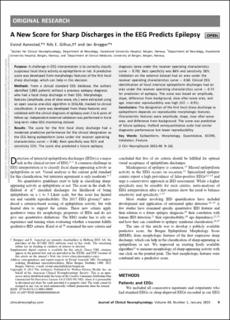A New Score for Sharp Discharges in the EEG Predicts Epilepsy
Journal article, Peer reviewed
Published version

Åpne
Permanent lenke
https://hdl.handle.net/11250/2767233Utgivelsesdato
2023Metadata
Vis full innførselSamlinger
- Department of Clinical Medicine [2044]
- Registrations from Cristin [9489]
Originalversjon
Journal of clinical neurophysiology. 2023, 40 (1), 9-16. 10.1097/WNP.0000000000000849Sammendrag
Purpose: A challenge in EEG interpretation is to correctly classify suspicious focal sharp activity as epileptiform or not. A predictive score was developed from morphologic features of the first focal sharp discharge, which can help in this decision.
Methods: From a clinical standard EEG database, the authors identified 2,063 patients without a previous epilepsy diagnosis who had a focal sharp discharge in their EEG. Morphologic features (amplitude, area of slow wave, etc.) were extracted using an open source one-click algorithm in EEGLAB, masked to clinical classification. A score was developed from these features and validated with the clinical diagnosis of epilepsy over 2 to 6 years of follow-up. Independent external validation was performed in Kural long-term video-EEG monitoring dataset.
Results: The score for the first focal sharp discharge had a moderate predictive performance for the clinical designation as the EEG being epileptiform (area under the receiver operating characteristics curve = 0.86). Best specificity was 91% and sensitivity 55%. The score also predicted a future epilepsy diagnosis (area under the receiver operating characteristics curve = 0.70). Best specificity was 86% and sensitivity 38%. Validation on the external dataset had an area under the receiver operating characteristics curve = 0.80. Clinical EEG identification of focal interictal epileptiform discharges had an area under the receiver operating characteristics curve = 0.73 for prediction of epilepsy. The score was based on amplitude, slope, difference from background, slow after-wave area, and age. Interrater reproducibility was high (ICC = 0.91).
Conclusions: The designation of the first focal sharp discharge as epileptiform depends on reproducible morphologic features. Characteristic features were amplitude, slope, slow after-wave area, and difference from background. The score was predictive of future epilepsy. Halford semiquantitative scale had similar diagnostic performance but lower reproducibility.
